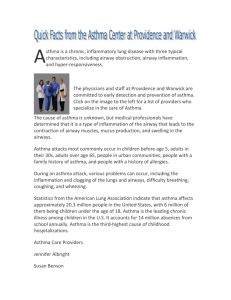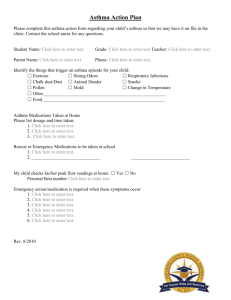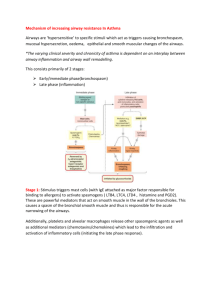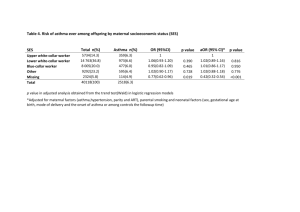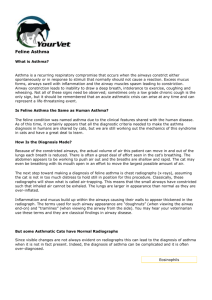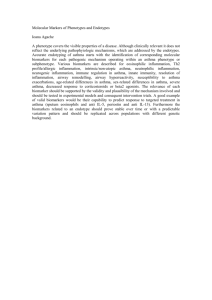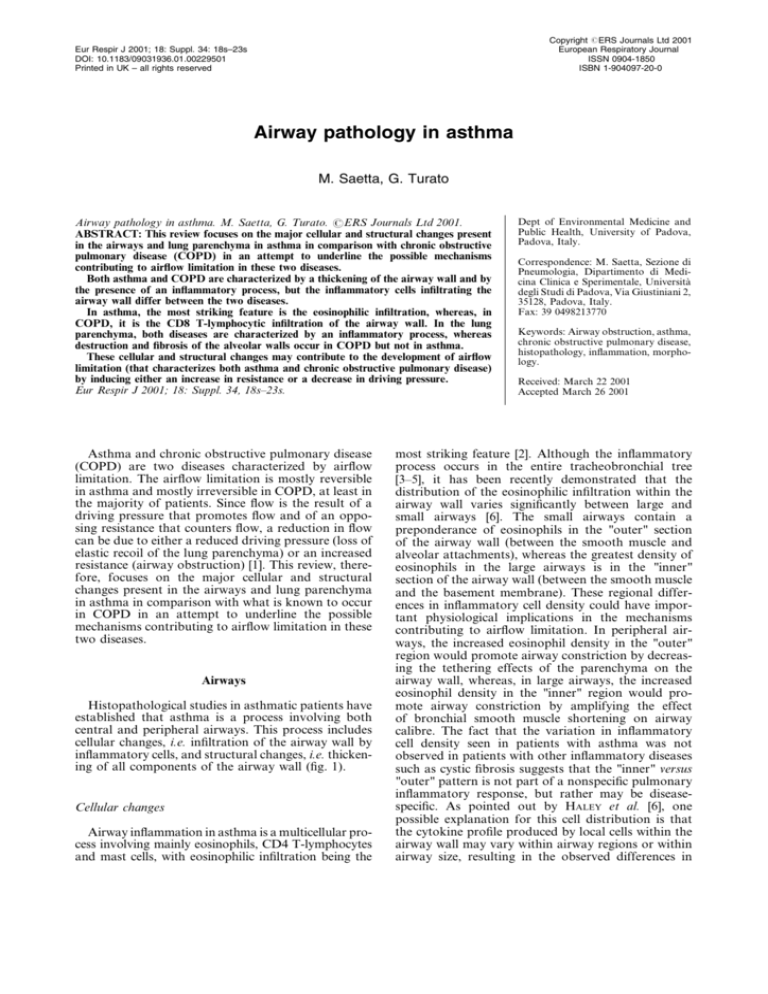
Copyright #ERS Journals Ltd 2001
European Respiratory Journal
ISSN 0904-1850
ISBN 1-904097-20-0
Eur Respir J 2001; 18: Suppl. 34: 18s–23s
DOI: 10.1183/09031936.01.00229501
Printed in UK – all rights reserved
Airway pathology in asthma
M. Saetta, G. Turato
Airway pathology in asthma. M. Saetta, G. Turato. #ERS Journals Ltd 2001.
ABSTRACT: This review focuses on the major cellular and structural changes present
in the airways and lung parenchyma in asthma in comparison with chronic obstructive
pulmonary disease (COPD) in an attempt to underline the possible mechanisms
contributing to airflow limitation in these two diseases.
Both asthma and COPD are characterized by a thickening of the airway wall and by
the presence of an inflammatory process, but the inflammatory cells infiltrating the
airway wall differ between the two diseases.
In asthma, the most striking feature is the eosinophilic infiltration, whereas, in
COPD, it is the CD8 T-lymphocytic infiltration of the airway wall. In the lung
parenchyma, both diseases are characterized by an inflammatory process, whereas
destruction and fibrosis of the alveolar walls occur in COPD but not in asthma.
These cellular and structural changes may contribute to the development of airflow
limitation (that characterizes both asthma and chronic obstructive pulmonary disease)
by inducing either an increase in resistance or a decrease in driving pressure.
Eur Respir J 2001; 18: Suppl. 34, 18s–23s.
Asthma and chronic obstructive pulmonary disease
(COPD) are two diseases characterized by airflow
limitation. The airflow limitation is mostly reversible
in asthma and mostly irreversible in COPD, at least in
the majority of patients. Since flow is the result of a
driving pressure that promotes flow and of an opposing resistance that counters flow, a reduction in flow
can be due to either a reduced driving pressure (loss of
elastic recoil of the lung parenchyma) or an increased
resistance (airway obstruction) [1]. This review, therefore, focuses on the major cellular and structural
changes present in the airways and lung parenchyma
in asthma in comparison with what is known to occur
in COPD in an attempt to underline the possible
mechanisms contributing to airflow limitation in these
two diseases.
Airways
Histopathological studies in asthmatic patients have
established that asthma is a process involving both
central and peripheral airways. This process includes
cellular changes, i.e. infiltration of the airway wall by
inflammatory cells, and structural changes, i.e. thickening of all components of the airway wall (fig. 1).
Cellular changes
Airway inflammation in asthma is a multicellular process involving mainly eosinophils, CD4 T-lymphocytes
and mast cells, with eosinophilic infiltration being the
Dept of Environmental Medicine and
Public Health, University of Padova,
Padova, Italy.
Correspondence: M. Saetta, Sezione di
Pneumologia, Dipartimento di Medicina Clinica e Sperimentale, Università
degli Studi di Padova, Via Giustiniani 2,
35128, Padova, Italy.
Fax: 39 0498213770
Keywords: Airway obstruction, asthma,
chronic obstructive pulmonary disease,
histopathology, inflammation, morphology.
Received: March 22 2001
Accepted March 26 2001
most striking feature [2]. Although the inflammatory
process occurs in the entire tracheobronchial tree
[3–5], it has been recently demonstrated that the
distribution of the eosinophilic infiltration within the
airway wall varies significantly between large and
small airways [6]. The small airways contain a
preponderance of eosinophils in the "outer" section
of the airway wall (between the smooth muscle and
alveolar attachments), whereas the greatest density of
eosinophils in the large airways is in the "inner"
section of the airway wall (between the smooth muscle
and the basement membrane). These regional differences in inflammatory cell density could have important physiological implications in the mechanisms
contributing to airflow limitation. In peripheral airways, the increased eosinophil density in the "outer"
region would promote airway constriction by decreasing the tethering effects of the parenchyma on the
airway wall, whereas, in large airways, the increased
eosinophil density in the "inner" region would promote airway constriction by amplifying the effect
of bronchial smooth muscle shortening on airway
calibre. The fact that the variation in inflammatory
cell density seen in patients with asthma was not
observed in patients with other inflammatory diseases
such as cystic fibrosis suggests that the "inner" versus
"outer" pattern is not part of a nonspecific pulmonary
inflammatory response, but rather may be diseasespecific. As pointed out by HALEY et al. [6], one
possible explanation for this cell distribution is that
the cytokine profile produced by local cells within the
airway wall may vary within airway regions or within
airway size, resulting in the observed differences in
AIRWAY PATHOLOGY IN ASTHMA
Fig. 1. – Photomicrographs showing a bronchiole from a subject
who died during an asthma attack. a) Luminal occlusion caused
by muscle constriction, thickening of the airway wall, increased
smooth muscle mass and a marked inflammatory process in the
airway wall, mainly characterized by eosinophils. b) Detail from
a). The distribution of the inflammatory process is more obvious:
there is a greater density of eosinophils in the area outside the
smooth muscle ("outer" region) than in that inside it ("inner"
region). (Haematoxylin and eosin staining).
patterns of inflammatory cells density. The functional
consequences of this cell distribution remain speculative. It is possible that different cell localization and
different microenvironment influence the local production of mediators by inflammatory cells. For
example, factors released immediately adjacent to
smooth muscle are likely to exert a greater effect on
smooth muscle than factors released distant from it.
Although it is well accepted that asthma is characterized by eosinophilic infiltration, there has been
accumulating evidence that prominent neutrophilia
occurs in situations associated with severe asthma
[7–10]. Neutrophil levels have been shown to be
elevated in sputum from exacerbated asthmatics [7],
bronchial washes from patients intubated for status
asthmaticus [8], autopsy samples from patients who
died suddenly of asthma [9] and severe steroiddependent asthma [10]. It is possible that, in steroiddependent asthma, the neutrophilia is due to the
corticosteroid therapy itself, which has been shown to
reduce eosinophil number and to increase neutrophil
numbers, by inhibition of neutrophil apoptosis [11].
However, there are other possible explanations for the
prominent neutrophilia observed in asthma when the
19s
disease becomes severe [10]. The first possible explanation is that the neutrophils are present because the
pathology changes when the disease becomes severe.
Alternatively, the neutrophils could be present as a
response to an altered milieu, perhaps infectious, in
the airways. Finally, it is also possible that the
neutrophils, although present in the airways, are not
contributing in any way to the pathological process
but simply represent a marker of severity of the
disease.
In severe steroid-dependent asthma, WENZEL et al.
[10] reported a marked predominance of neutrophils
over eosinophils in bronchoalveolar lavage fluid and
in bronchial and transbronchial biopsy samples, i.e. in
the lumen, bronchial wall and alveolar walls. These
results suggest that a novel form of inflammation, that
is different from that seen in moderate asthmatics, is
observed in the majority of severe asthmatics on high
doses of corticosteroids. Despite the fact that asthma
is not a single disease entity, but rather a complex of
conditions that contribute to airflow limitation, clinicians tend to treat all asthmatics in a similar manner.
As pointed out by WENZEL et al. [10], this may be due
to a lack of pathological data, which could help to
distinguish between different subgroups of patients. In
this context, the finding of different types of inflammation in severe and moderate asthma provides
pathological evidence of heterogeneity of the disease
that may explain the different response to therapy in
individual patients.
WENZEL et al. [12] subsequently further analysed the
subjects with severe steroid-dependent asthma, and
obtained evidence that the phenotype of "severe
asthma" is composed of at least two distinct pathological subtypes (based on the presence or absence of
eosinophils) with distinct physiological and clinical
characteristics. Patients with and without eosinophilia
demonstrated similar degrees of airway obstruction
and both had persistently elevated neutrophil numbers despite high doses of corticosteroids. However,
patients with eosinophilia showed a greater total
amount of inflammatory cell infiltrate (including
T-lymphocytes and mast cells), thicker subepithelial
basement membrane and higher incidence of respiratory failure as compared to patients without eosinophilia. Which specific cytokines are driving the
inflammatory process in the two groups of severe
asthmatics is still unknown. It is possible that
cytokines inducing "classic" asthmatic inflammation
(increased numbers of eosinophils, T-lymphocytes and
mast cells associated with thickening of the subepithelial basement membrane) are involved in the group
with eosinophilia, whereas different cytokines are
probably involved in the group without eosinophilia,
that showed virtually no evidence of "classic" asthmatic inflammation. As stated by WENZEL et al. [12], it
is currently impossible to determine whether this latter
group had demonstrated a distinct pathology since
disease onset or whether eosinophils were lost as a
consequence of corticosteroid therapy. Whatever the
explanation, the tissue level response appears to be
different in the two groups of severe asthmatics.
It is now well accepted that COPD is also characterized by an airway inflammatory process, but that the
20s
M. SAETTA, G. TURATO
inflammatory cells infiltrating the airway wall are
different from those observed in asthma [13–16]. In
COPD, T-lymphocytes and macrophages are the
predominant cells, with CD8 T-lymphocyte infiltration being the most striking feature in both the large
and small airways. Interestingly, not only are CD8
T-lymphocytes increased in number but their numbers
also correlate with the degree of airway obstruction
[15, 16], supporting a role for airway inflammation in
the development of airflow limitation in smokers.
When COPD becomes severe, prominent neutrophilia
occurs [17], confirming that there is an association
between neutrophilia and disease severity, as in
asthma.
Structural changes
The airway wall of patients with asthma is characterized by increased smooth muscle mass, mucous
gland hypertrophy and vascular congestion leading to
a thickened airway wall and markedly reduced airway
calibre [18–23]. These features may contribute
to the development of airflow limitation by increasing
airway resistance. The effect on flow is enhanced by
the presence of increased amounts of mucus and
inflammatory exudate, which not only blocks the airway passages but also causes an increased surface
tension favouring airway closure. This excessive mucus
secretion is due not only to hypertrophy of mucous
glands [21, 22], but also to hyperplasia of goblet cells,
which has also been reported in the airway epithelium of asthmatic subjects [24, 25].
The increase in smooth muscle mass may be due to
several factors, including proliferation of smooth
muscle induced by inflammatory mediators [26], cytokines [27] and growth factors [28, 29]. It has been
suggested that an intrinsic abnormality of smooth
muscle may underlie asthma severity, but data are
lacking to support this hypothesis. The major functional consequence of the increase in smooth muscle
mass is that, in an airway with a thickened wall, the
same degree of smooth muscle shortening may cause
considerably greater luminal narrowing than in a
normal airway [30].
An important component of airway wall thickening
is vascular congestion. An increased vessel area in the
airway wall has been reported in subjects who died
during an asthma attack as compared to subjects with
mild nonfatal asthma, suggesting a role for vascular
congestion in the reduction of airway calibre that
characterizes a fatal attack [20]. However, these
results were not confirmed in a subsequent study
that found no differences in vascular congestion
between fatal and mild nonfatal asthma [23].
It is now well accepted that, in asthma, there is
increased thickness of the reticular basement membrane [31, 32]. This thickening is due to the deposition
of collagen types I, III and V, as elegantly shown by
ROCHE et al. [31], and so is more properly called
"subepithelial fibrosis". Intriguingly, the majority of
studies have shown that this thickening correlates with
neither the severity nor the duration of asthma [33,
34]. However, one study [35] has shown a correlation
between increased thickness of the reticular basement
membrane and severity of disease, supporting the role
of subepithelial fibrosis in the development of airflow
limitation in asthma.
Whereas collagen deposition has been measured in
the basement membrane in most studies, only a few
have investigated collagen deposition in the rest of the
airway wall [31, 32, 36, 37]. Evaluation of this deeper
submucosal collagen deposition may be important,
since it may contribute (more than the basement
membrane) to the total thickness of the airway wall.
CHU et al. [37] hypothesized that, in severe steroiddependent asthma, the disease may be refractory to
therapy because the airways are more "fibrosed" or
"remodelled" than in mild asthma. They, therefore,
examined collagen deposition in the deeper submucosa in four groups of subjects: controls, mild
asthmatics, moderate asthmatics, and severe steroiddependent asthmatics. The amount of collagen deposition was similar in the four groups of subjects
examined, suggesting that the degree of fibrosis in the
deeper submucosa cannot explain the differences in
severity of asthma. As both the severe and moderate
asthmatics received corticosteroids, it is possible that
the lack of differences in collagen deposition among
asthmatic groups was secondary to an effect of
therapy. Despite similar collagen deposition (whether
or not due to corticosteroids), severe asthmatics were
clinically different from the other groups, with
ongoing symptoms, poor pulmonary function, and
oral corticosteroid requirements. As underlined by
CHU et al. [37], these observations suggest that airway
collagen deposition is not a key contributor to the
symptoms and pathophysiology of asthma.
Thickening of the subepithelial reticular basement
membrane does not occur in COPD, at least in the
majority of subjects [38]. By contrast, fibrosis of the
total wall has been reported in this disease [39],
although more studies are needed to support this
observation.
Thickening of the airway wall, hypertrophy of
mucous glands, increased smooth muscle mass and
hyperplasia of goblet cells have been reported in
patients with COPD [16, 40, 41]. Moreover, both
thickness of smooth muscle [16] and number of goblet
cells [41] correlate with the degree of airway obstruction in this disease, supporting a role for airway
remodelling and mucus hypersecretion in the development of airflow limitation in smokers.
Lung parenchyma
Only a few studies have examined the cellular
changes in the alveolar walls of patients with asthma,
and even less information is available regarding the
structural changes that occur in the lung parenchyma
of these patients.
Cellular changes
The few studies examining inflammation of the lung
parenchyma in asthma have been performed by a group
in Denver, CO, USA, who analysed transbronchial
21s
AIRWAY PATHOLOGY IN ASTHMA
biopsy samples obtained from subjects with nocturnal
asthma [42, 43] and from subjects with severe steroiddependent asthma [10].
In patients with nocturnal asthma, respiratory
symptoms worsen considerably at night. Studying
inflammatory changes in nocturnal asthma, therefore,
provides a model for relating these changes to worsening of the condition in a naturally occurring situation [44]. The inflammatory response in the alveolar
walls is considerably greater at night in patients
who experience nocturnal asthma. Analyses of transbronchial biopsy samples [42, 43] have shown that
the overnight decrease in lung function correlates
with increased numbers of eosinophils and CD4
T-lymphocytes in the alveolar tissue, supporting a
role for parenchymal inflammation in the acute
worsening of the condition.
As has been seen before, patients with severe
steroid-dependent asthma demonstrate an inflammatory process in the alveolar walls that is characterized
by prominent neutrophilia [10]. Whether this neutrophilia represents an effect of corticosteroids or simply
a marker of severity of the disease remains to be
investigated.
Inflammatory changes in the alveolar region are
also reported in COPD. Lymphocytes, particularly
CD8 T-lymphocytes, and macrophages have been
demonstrated to form a significant component of
this alveolar wall inflammatory infiltrate [45, 46].
The correlation between increased number of CD8
T-lymphocytes in the alveolar walls and reduced
expiratory airflow observed in smokers [45] supports
a role for these cells in the development of chronic
airflow limitation in smokers.
cells. In asthma, the distribution of the eosinophilic
infiltration differs between the central and peripheral
airways, and this pattern of distribution may have
important functional consequences. When the disease
becomes severe, prominent neutrophilia occurs in
both asthma and COPD, but the mechanisms underlying the recruitment of neutrophils are still unclear.
Thickening of the airway wall, increased smooth
muscle mass, hypertrophy of mucous glands and
goblet cell hyperplasia have been reported in both
asthma and COPD, whereas the extent of the fibrosis
differs in the two diseases. In asthma, it is localized in
the area just beneath the epithelium even in patients
with severe disease, whereas, in COPD, it may involve
the entire airway wall.
From the point of view of the parenchyma, both
asthma and COPD are characterized by an inflammatory process in the alveolar walls (even though the
predominant cell phenotype differs), whereas destruction and fibrosis of the alveolar walls occur in COPD
but not in asthma.
These cellular and structural changes may contribute to the development of airflow limitation (that
characterizes the two diseases) by inducing either an
increase in resistance or a decrease in driving pressure.
Whether or not these changes explain the reversible
and irreversible component of airflow limitation still
remains to be investigated.
References
1.
2.
Structural changes
While parenchymal destruction is a characteristic
feature of COPD [47], it is uncommon in asthma [18],
even though more studies are needed to confirm the
lack of parenchymal destruction in asthmatic lungs.
Emphysema, which is one of the major causes of
COPD, is defined anatomically as a permanent
"destructive" enlargement of airspaces distal to the
terminal bronchioles, without obvious fibrosis [47].
However, this last statement (without obvious fibrosis) has been the subject of recent debate. New data
have shown that, in emphysema, the destructive
process is accompanied by a net increase in the mass
of collagen, suggesting that, contrary to the definition
of the disease, active alveolar wall fibrosis does indeed
occur in emphysematous lungs [48, 49].
3.
4.
5.
6.
7.
Conclusions
From the point of view of the airways, both asthma
and COPD are characterized by an inflammatory
process, but the inflammatory cells infiltrating the
airway wall differ in the two diseases. In asthma, CD4
T-lymphocytes, eosinophils and mast cells are the
predominant cells involved, whereas, in COPD, CD8
T-lymphocytes and macrophages are the predominant
8.
9.
10.
Saetta M, Finkelstein R, Cosio MG. Morphological
and cellular basis for airflow limitation in smokers.
Eur Respir J 1994; 7: 1505–1515.
Sheffer AL, ed. Global Initiative for Asthma. Global
strategy for asthma management and prevention.
NHLBI/WHO Workshop report. National Institutes
of Health, National Heart, Lung and Blood Institute.
Publication No. 95-3659. 1995.
Carrol N, Cooke C, James A. The distribution of
eosinophils and lymphocytes in the large and small
airways of asthmatics. Eur Respir J 1997; 10: 292–300.
Synek M, Beasley R, Frew AJ, et al. Cellular
infiltration of the airways in asthma of varying
severity. Am Respir Crit Care Med 1996; 154: 224–230.
Bousquet J, Jeffery PK, Busse WW, Johnson M,
Vignola A. Asthma: from bronchoconstriction to
airways inflammation and remodeling. Am J Respir
Crit Care Med 2000; 161: 1720–1745.
Haley KJ, Sunday ME, Wiggs ES, et al. Inflammatory
cell distribution within and along asthmatic airways.
Am J Respir Crit Care Med 1998; 158: 565–572.
Fahy JV, Kim KW, Liu J, Boushey HA. Prominent
neutrophilic inflammation in sputum from subjects
with asthma exacerbations. J Allergy Clin Immunol
1995; 4: 843–852.
Lamblin C, Gosset P, Tillie-Leblond I, et al. Bronchial
neutrophilia in patients with nonifectious status
asthmaticus. Am J Respir Crit Care Med 1998; 157:
394–402.
Sur S, Crotty TB, Gail M, et al. Sudden onset fatal
asthma. Am Rev Respir Dis 1993; 148: 713–719.
Wenzel SE, Szefler SJ, Leung DYM, Sloan SI, Rex
MD, Martin RJ. Bronchoscopic evaluation of severe
22s
11.
12.
13.
14.
15.
16.
17.
18.
19.
20.
21.
22.
23.
24.
25.
26.
27.
M. SAETTA, G. TURATO
asthma. Persistent inflammation associated with high
dose glucocorticoids. Am J Respir Crit Care Med
1997; 156: 737–743.
Cox G. Glucocorticoid treatment inhibits apoptosis in
human neutrophils. J Immunol 1995; 154: 4719–4725.
Wenzel SE, Schwartz LB, Langmack EL, et al.
Evidence that asthma can be divided pathologically
into two inflammatory subtypes with distinct physiologic and clinical characteristics. Am J Respir Crit
Care Med 1999; 160: 1001–1008.
Saetta M, Di Stefano A, Maestrelli P, et al. Activated
T-lymphocytes and macrophages in bronchial mucosa
of subjects with chronic bronchitis. Am Rev Respir Dis
1993; 147: 301–306.
Di Stefano A, Turato G, Maestrelli P, et al. Airflow
limitation in chronic bronchitis is associated with
T-lymphocyte and macrophage infiltration in the
bronchial mucosa. Am J Respir Crit Care Med 1996;
153: 629–632.
O9Shaughnessy TC, Ansari TW, Barnes NC, Jeffery
PK. Inflammation in bronchial biopsies of subjects
with chronic bronchitis: inverse relationship of CD8z
T lymphocytes with FEV1. Am J Respir Crit Care Med
1997; 155: 852–857.
Saetta M, Di Stefano A, Turato G, et al. CD8z
T-lymphocytes in the peripheral airways of smokers
with chronic obstructive pulmonary disease. Am
J Respir Crit Care Med 1998; 157: 822–826.
Di Stefano A, Capelli A, Lusuardi M, et al. Severity of
airflow limitation is associated with severity of airway
inflammation in smokers. Am J Respir Crit Care Med
1998; 158: 1277–1285.
Dunnill M, Massarella G, Anderson J. Comparison of
the quantitative anatomy of the bronchi in normal
subjects, in status asthmaticus, in chronic bronchitis
and in emphysema. Thorax 1969; 24: 176–179.
Saetta M, Di Stefano A, Rosina C, Thiene G, Fabbri
LM. Quantitative structural analysis of peripheral
airways and arteries in sudden fatal asthma. Am Rev
Respir Dis 1991; 143: 138–143.
Kuwano K, Bosken CH, Parè PD, Bay TR, Wiggs
BR, Hogg JC. Small airways dimensions in asthma
and in chronic obstructive pulmonary disease. Am Rev
Respir Dis 1993; 148: 1220–1225.
Carroll N, Elliott J, Morton A, James A. The
structure of large and small airways in nonfatal and
fatal asthma. Am Rev Respir Dis 1993; 147: 405–410.
Carroll N, Carello S, Cooke C, James A. Airway
structure and inflammatory cells in fatal attacks of
asthma. Eur Respir J 1996; 9: 709–715.
Carrol NG, Cooke C, James AL. Bronchial blood
vessel dimensions in asthma. Am J Respir Crit Care
Med 1997; 155: 689–695.
Aikawa T, Shimura S, Sasaki H, Ebina M, Takishima
T. Marked goblet cell hyperplasia with mucus
accumulation in the airways of patients who died of
severe acute asthma attack. Chest 1992; 101: 916–921.
Shimura S, Andoh Y, Haraguchi M, Shirato K.
Continuity of airway goblet cells and intraluminal
mucus in the airways of patients with bronchial
asthma. Eur Respir J 1996; 9: 1395–1401.
Noveral JP, Grunstein MM. Role and mechanism of
thromboxane-induced proliferation of cultured airway
smooth muscle cells. Am J Physiol 1992; 263: L555–
L561.
De S, Zelazny ET, Souhrada JF, Souhrada M. Il-1b
and Il-6 induce hyperplasia and hypertrophy of
28.
29.
30.
31.
32.
33.
34.
35.
36.
37.
38.
39.
40.
41.
42.
43.
44.
cultured guinea pig airway smooth muscle cells.
J Appl Physiol 1995; 78: 1555–1563.
Noveral JP, Rosemberg SM, Anbar RA, Pawlowski
NA, Grunstein MM. Role of endothelin-1 and
epidermal growth factor in cultured airway smooth
muscle. Am J Physiol 1992; 263: L317–L324.
Stewart AG, Grigoriadis G, Harris T. Mitogenic actions of endothelin-1 and epidermal growth
factor in cultured airway smooth muscle. Clin Exp
Pharmacol Physiol 1994; 21: 277–285.
Lambert RK, Wiggs BR, Kuwano K, Hogg JC, Parè
PD. Functional significance of increased airway
smooth muscle in asthma and COPD. J Appl Physiol
1993; 74: 2771–2781.
Roche WR, Beasley R, Williams JH, Holgate ST.
Subepithelial fibrosis in the bronchi of asthmatics.
Lancet 1989; i: 520–524.
Wilson JW, Li X. The measurement of reticular
basement membrane and submucosal collagen in
asthmatic airways. Clin Exp Allergy 1997; 27: 363–
371.
Jeffery PK, Wardlaw AJ, Nelson FC, Collins JV,
Kay AB. Bronchial biopsies in asthma: an ultrastructural quantitative study and correlation with hyperreactivity. Am Rev Respir Dis 1989; 140: 1745–1753.
Saetta M, Maestrelli P, Di Stefano A, et al. Effect of
cessation of exposure to toluene diisocyanate (TDI) on
bronchial mucosa of subjects with TDI induced
asthma. Am Rev Respir Dis 1992; 145: 169–174.
Chetta A, Foresi A, Del Donno M, Bertorelli G,
Pesci A, Olivieri D. Airway remodeling is a distinctive feature of asthma, and is related to severity of
disease. Chest 1997; 111: 852–857.
Godfrey RWA, Lorimer S, Majumdar S, et al. Airway
and lung elastic fiber is not reduced in asthma nor in
asthmatics following corticosteroid treatment. Eur
Respir J 1995; 8: 922–927.
Chu HW, Halliday JL, Martin RJ, Leung DYM,
Szefler SJ, Wenzel SE. Collagen deposition in large
airways may not differentiate severe asthma from
milder forms of the disease. Am J Respir Crit Care
Med 1998; 158: 1936–1944.
Jeffery PK. Comparison of the structural and inflammatory features of COPD and asthma. Chest 2000;
117: 251S–260S.
Cosio M, Ghezzo H, Hogg JC, et al. The relations
between structural changes in small airways and
pulmonary function tests. N Engl J Med 1978; 298:
1277–1281.
Reid L. Measurement of the bronchial mucous gland
layer: a diagnostic yardstick in chronic bronchitis.
Thorax 1960; 15: 132–141.
Saetta M, Turato G, Baraldo S, et al. Goblet cell
hyperplasia and epithelial inflammation in peripheral
airways of smokers with both symptoms of chronic
bronchitis and airflow limitation. Am J Respir Crit
Care Med 2000; 161: 1016–1021.
Kraft M, Djukanovich R, Wilson S, Holgate ST,
Martin RJ. Alveolar tissue inflammation in asthma.
Am J Respir Crit Care Med 1996; 154: 1505–1510.
Kraft M, Martin RJ, Wilson S, Djukanovich R,
Holgate ST. Lymphocyte and eosinophil influx into
alveolar tissue in nocturnal asthma. Am J Respir Crit
Care Med 1999; 159: 228–234.
Holgate ST. Inflammatory and structural changes in
the airways of patients with asthma. Respir Med 2000;
94: S3–S6.
AIRWAY PATHOLOGY IN ASTHMA
45.
46.
47.
Saetta M, Baraldo S, Corbino L, et al. CD8zve cells
in the lungs of smokers with chronic obstructive
pulmonary disease. Am J Respir Crit Care Med 1999;
160: 711–717.
Finkelstein R, Fraser RS, Ghezzo H, Cosio MG.
Alveolar inflammation and its relationship to emphysema in smokers. Am J Respir Crit Care Med 1995;
152: 1666–1672.
American Thoracic Society. Standards for diagnosis and care of patients with chronic obstructive
48.
49.
23s
pulmonary disease. Am Rev Respir Dis 1995; 152: S77–
S120.
Lang MR, Fiaux GW, Gilooly M, Stewart JA,
Hulmes DJS, Lamb D. Collagen content of alveolar
wall tissue in emphysematous and non-emphysematous
lungs. Thorax 1994; 49: 319–326.
Vlahovic G, Russell ML, Mercer RR, Crapo JD.
Cellular and connective tissue changes in alveolar
septal walls in emphysema. Am J Respir Crit Care
Med 1999; 160: 2086–2092.

